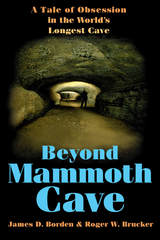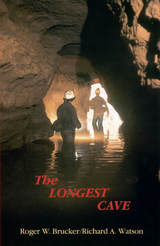
In Beyond Mammoth Cave: A Tale of Obsession in the World’s Longest Cave, James D. Borden and Roger W. Brucker provide gripping first-person accounts of the discoveries, including Roppel Cave, that made Kentucky’s Mammoth Cave three times longer than any other cave in the world.
Borden, a relative newcomer, and Brucker, a veteran explorer, bring a personal and sometimes conflicting view of their roles as adversaries in a race that lasted from 1972 through 1983 to find “big cave.” They describe hazardous adventures, precarious climbs, and close calls from falling rocks. The perils are many and the trek arduous as they squirm through muddy tubes, wade in neck-deep cold water, and crawl over sharp rocks and gritty sand. Theirs is a tale of agonizing endurance spiced by spectacular discoveries.
But the cave was not the sole obstacle. The explorations were complicated by political intrigue and the rivalry between the Kentucky-based Cave Research Foundation and the Central Kentucky Karst Coalition, each seeking to make discoveries and hide secrets. Extreme stress, of course, evoked extreme behavior, ranging from selfishness to sacrifice, from outrageous humor to the deadly serious response.
Beyond Mammoth Cave includes maps by Patricia Kambesis that show the progression of cave discoveries in relation to the topography. Original line drawings by well-known illustrator Linda Heslop capture the dark mystery of the exploration. The book features five black and white photographs as a color gallery of photographs.
A sequel to The Longest Cave by Brucker and Richard A. Watson, this book is a comprehensive update of the speleological investigations in the Mammoth Cave region. Brucker’s involvement provides continuity to the investigation.

In 1925 the geological connection between Flint Ridge and Mammoth Cave was proved when dye placed in a Flint Ridge spring showed up in Echo River at Mammoth Cave.
That tantalizing swirl of dye confirmed speculations that wereto tempt more than 650cavers over half a century with the thrill of being the first to make human passage of the cave connection. Roger Brucker and Richard Watson tell not only of their own twenty-year effort to complete the link but the stories of many others who worked their way through mud-choked crawlways less than a foot high only to find impenetrable blockages.
Floyd Collins died a grisly death in nearby Sand Cave in1925, after being trapped there for 15 days. The wide press coverage of the rescue efforts stirred the imagination of the public and his body was on macabre display in a glass-topped coffin in Crystal Cave into the 1940s. Agents of a rival cave owner once even stole his corpse, which was recovered and still is in a coffin in the cave. Modern cavers still have a word with Floyd as they start their downward treks.
Brucker and Watson joined the parade of cavers who propelled themselves by wiggling kneecaps, elbows, and toes through quarter-mile long crawlways, clinging by fingertips and boot toes across mud-slick walls, over bottomless pits, into gurgling streams beneath stone ceilings that descend to water level, down crumbling crevices and up mountainous rockfalls, into wondrous domed halls, and straight ahead into a blackness intensified rather than dispelled by the carbide lamps on their helmets.
Over two decades they explored the passages with others who sought the final connection as vigorously as themselves. Pat Crowther, a young mother of two, joined them and because of her thinness became the member of the crew to go first into places no human had ever gone before. In that role, in July 1972, she wiggled her way through the Tight Spot and found the route that would link the Flint Ridge and Mammoth Cave systems into one cave extending 144.4 miles through the Kentucky limestone.
In a new afterword to this edition the authors summarize the subsequent explorations that have more than doubled the established length of the cave system. Based upon geological evidence, the authors predict that new discoveries will add another 200 miles to the length of the world’s longest cave, making it over 500 miles long.
READERS
Browse our collection.
PUBLISHERS
See BiblioVault's publisher services.
STUDENT SERVICES
Files for college accessibility offices.
UChicago Accessibility Resources
home | accessibility | search | about | contact us
BiblioVault ® 2001 - 2024
The University of Chicago Press









